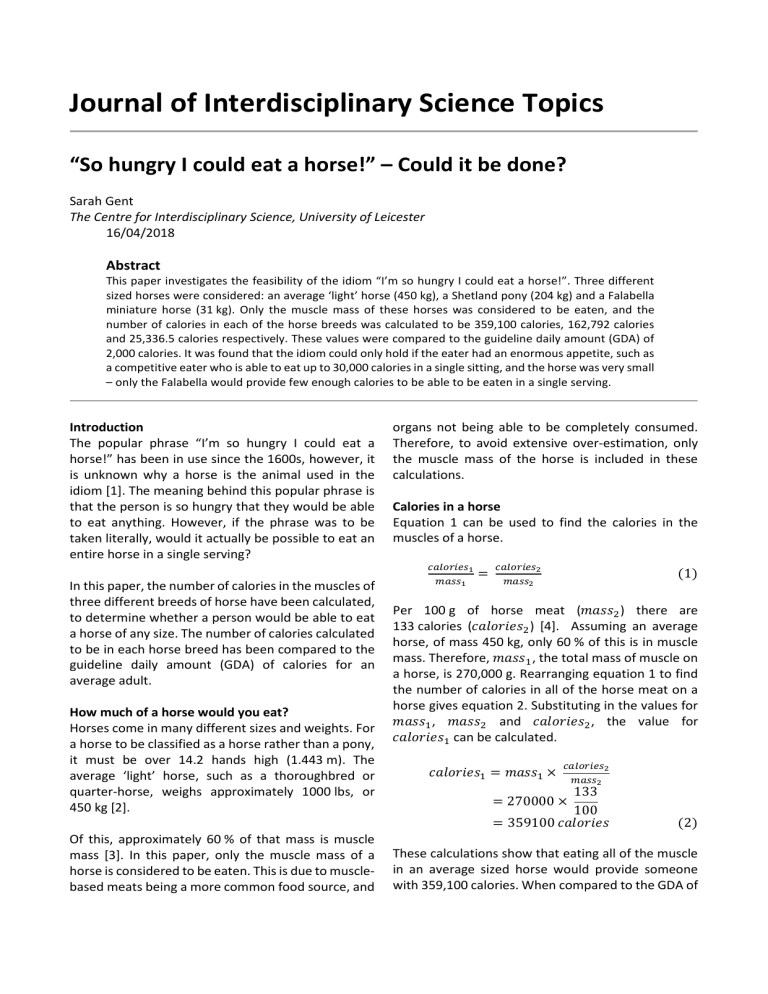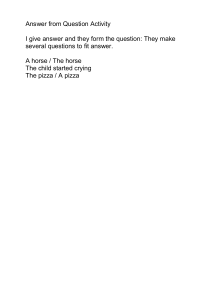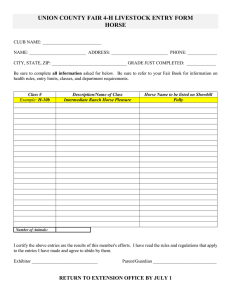
Journal of Interdisciplinary Science Topics “So hungry I could eat a horse!” – Could it be done? Sarah Gent The Centre for Interdisciplinary Science, University of Leicester 16/04/2018 Abstract This paper investigates the feasibility of the idiom “I’m so hungry I could eat a horse!”. Three different sized horses were considered: an average ‘light’ horse (450 kg), a Shetland pony (204 kg) and a Falabella miniature horse (31 kg). Only the muscle mass of these horses was considered to be eaten, and the number of calories in each of the horse breeds was calculated to be 359,100 calories, 162,792 calories and 25,336.5 calories respectively. These values were compared to the guideline daily amount (GDA) of 2,000 calories. It was found that the idiom could only hold if the eater had an enormous appetite, such as a competitive eater who is able to eat up to 30,000 calories in a single sitting, and the horse was very small – only the Falabella would provide few enough calories to be able to be eaten in a single serving. Introduction The popular phrase “I’m so hungry I could eat a horse!” has been in use since the 1600s, however, it is unknown why a horse is the animal used in the idiom [1]. The meaning behind this popular phrase is that the person is so hungry that they would be able to eat anything. However, if the phrase was to be taken literally, would it actually be possible to eat an entire horse in a single serving? In this paper, the number of calories in the muscles of three different breeds of horse have been calculated, to determine whether a person would be able to eat a horse of any size. The number of calories calculated to be in each horse breed has been compared to the guideline daily amount (GDA) of calories for an average adult. How much of a horse would you eat? Horses come in many different sizes and weights. For a horse to be classified as a horse rather than a pony, it must be over 14.2 hands high (1.443 m). The average ‘light’ horse, such as a thoroughbred or quarter-horse, weighs approximately 1000 lbs, or 450 kg [2]. Of this, approximately 60 % of that mass is muscle mass [3]. In this paper, only the muscle mass of a horse is considered to be eaten. This is due to musclebased meats being a more common food source, and organs not being able to be completely consumed. Therefore, to avoid extensive over-estimation, only the muscle mass of the horse is included in these calculations. Calories in a horse Equation 1 can be used to find the calories in the muscles of a horse. 𝑐𝑐𝑐𝑐𝑐𝑐𝑐𝑐𝑐𝑐𝑐𝑐𝑐𝑐𝑐𝑐1 𝑚𝑚𝑚𝑚𝑚𝑚𝑚𝑚1 = 𝑐𝑐𝑐𝑐𝑐𝑐𝑐𝑐𝑐𝑐𝑐𝑐𝑐𝑐𝑐𝑐2 𝑚𝑚𝑚𝑚𝑚𝑚𝑚𝑚2 (1) Per 100 g of horse meat (𝑚𝑚𝑚𝑚𝑚𝑚𝑠𝑠2 ) there are 133 calories (𝑐𝑐𝑐𝑐𝑐𝑐𝑐𝑐𝑐𝑐𝑐𝑐𝑐𝑐𝑠𝑠2 ) [4]. Assuming an average horse, of mass 450 kg, only 60 % of this is in muscle mass. Therefore, 𝑚𝑚𝑚𝑚𝑚𝑚𝑚𝑚1 , the total mass of muscle on a horse, is 270,000 g. Rearranging equation 1 to find the number of calories in all of the horse meat on a horse gives equation 2. Substituting in the values for 𝑚𝑚𝑚𝑚𝑚𝑚𝑠𝑠1 , 𝑚𝑚𝑚𝑚𝑚𝑚𝑠𝑠2 and 𝑐𝑐𝑐𝑐𝑐𝑐𝑐𝑐𝑐𝑐𝑐𝑐𝑐𝑐𝑠𝑠2, the value for 𝑐𝑐𝑐𝑐𝑐𝑐𝑐𝑐𝑐𝑐𝑐𝑐𝑐𝑐𝑠𝑠1 can be calculated. 𝑐𝑐𝑐𝑐𝑐𝑐𝑐𝑐𝑐𝑐𝑐𝑐𝑐𝑐𝑐𝑐1 = 𝑚𝑚𝑚𝑚𝑚𝑚𝑚𝑚1 × 𝑐𝑐𝑐𝑐𝑐𝑐𝑐𝑐𝑐𝑐𝑐𝑐𝑐𝑐𝑐𝑐2 𝑚𝑚𝑚𝑚𝑚𝑚𝑚𝑚2 133 100 = 359100 𝑐𝑐𝑐𝑐𝑐𝑐𝑐𝑐𝑐𝑐𝑐𝑐𝑐𝑐𝑐𝑐 = 270000 × (2) These calculations show that eating all of the muscle in an average sized horse would provide someone with 359,100 calories. When compared to the GDA of So hungry I could eat a horse! April 16th 2018 2,000 calories per day, this is much more [4]. According to the GDA, consuming a whole horse would provide a person with enough calories for approximately 180 days. Given that the calories from consuming all of the muscle of an average horse is far above the GDA, the calories of small horse breeds have been considered. A Shetland pony is a very small breed of pony that never exceeds 107 cm tall [5]. The average weight of a Shetland Pony is 204 kg [6], and using the assumption that 60 % of the mass is muscle [3], the average Shetland pony has 122,400 g of muscle. Substituting this into equation 2 gives a calorific output of 162,792 calories. For a 2,000 calorie per day diet [4], this is approximately 81 days’ worth of calories. Again, this is much greater than the GDA. The Falabella is a miniature horse, even smaller than Shetland ponies, reaching only approximately 80 cm in height [7]. They are considered horses rather than ponies, as they are bred to look identical to larger horse breeds, but in miniature [8]. The average weight of a Falabella is 31.75 kg [7]; 60 % of this is 19,050 g of muscle. Substituting this value into equation 2 gives a value of 25,336.5 calories, or approximately 13 days’ worth of calories. This number of calories still appears to be a lot for a normal human to eat in a single day – even on a day like Christmas day, most people do not even reach 10,000 calories [9]. However, competitive eaters can eat around 20,000 – 30,000 calories in a short space of time during a competition [10-11]. Therefore, for these people, it would be possible to eat a very small horse. Conclusion This paper has shown that eating the muscle of an average sized horse would not be possible for any person, as it contains too many calories – enough to sustain a person on a 2000 calorie a day diet for 180 days. This is also true for small Shetland ponies, which could sustain an average human for 81 days. However, the Falabella horse, at just over 31 kg, would provide 25,337 calories, making it possible that a competitive eater could eat a ‘horse’. References [1] Stackexchange (2017). Where does “I could eat a horse” come from? English Language and Usage. Available at: https://english.stackexchange.com/questions/380851/where-does-i-couldeat-a-horse-come-from [Accessed: 14th March 2018] [2] Briggs, K. (2000). Weighing In. The Horse. Available at: https://thehorse.com/14015/weighingin/ [Accessed: 14th March 2018] [3] Engfelt, C. (n.d.) Massage and muscles. Positive Riding. Available at: http://positiveriding.com/resourcelibrary/Massage&Muscles-Sec.pdf [Accessed: 14th March 2018] [4] Condé Nast (2014) Game meat, horse, raw: Nutrition, Facts, and Calories. Self Nutrition Data – know what you eat. Available at: http://nutritiondata.self.com/facts/lamb-veal-and-gameproducts/4639/2 [Accessed: 14th March 2018] [5] The Shetland Pony Stud-Book Society (2012) Breed Standard. Available at: http://www.shetlandponystudbooksociety.co.uk/about-the-breed/breed-standard [Accessed: 14th March 2018] [6] PetBreeds (2018a) Shetland Pony. Available at: http://horses.petbreeds.com/l/140/ShetlandPony [Accessed: 14th March 2018] So hungry I could eat a horse! April 16th 2018 [7] PetBreeds (2018b) Falabella. Available at: http://horses.petbreeds.com/l/12/Falabella [Accessed: 14th March 2018] [8] Arnold, J. (2016) What’s the Difference Between Mini Horses and Ponies? HorseChannel.com. Available at: http://www.horsechannel.com/horse-resources/whats-the-difference-betweenmini-horses-and-ponies.aspx [Accessed: 26th March 2018] [9] Larbi, M. (2017) How many calories are in a Christmas dinner? Metro. Available at: http://metro.co.uk/2017/11/30/how-many-calories-are-in-a-christmas-dinner-7120712/ [Accessed: 14th March 2018] [10] Lorenzo,T. (2012) The Calories Behind the Biggest Eating Records. Tailgate Fan. Available at: http://tailgatefan.cbslocal.com/2012/12/31/the-calories-behind-the-biggest-eating-records/ [Accessed: 14th March 2018] [11] Daily Mail Reporter (2010) Stuffed! The 30,000-calorie Christmas feast eaten by the world's fattest mum in ONE two-hour sitting. Daily Mail. Available at: http://www.dailymail.co.uk/news/article-1341683/Donna-Simpsons-feast-The-30-000-calorieChristmas-feast-eaten-worlds-fattest-mum-ONE-hour-sitting.html [Accessed: 14th March 2018]



